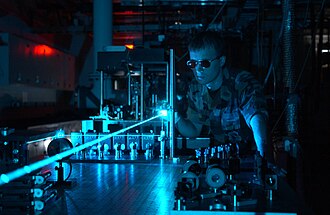Applied physics



Applied physics is a branch of physics that focuses on the practical application of physical principles and theories to solve real-world problems. It bridges the gap between pure physics and engineering, utilizing the fundamental concepts of physics to develop new technologies and improve existing ones.
Overview[edit]
Applied physics encompasses a wide range of subfields, including optics, materials science, nanotechnology, biophysics, and quantum electronics. Unlike theoretical physics, which seeks to understand the fundamental laws of nature, applied physics aims to use these laws to create practical devices and systems.
Subfields[edit]
Optics[edit]
Optics is the study of light and its interactions with matter. Applied optics involves the design and development of optical instruments such as lenses, microscopes, and telescopes. It also includes the study of laser technology and its applications in various fields, including medicine and communications.
Materials Science[edit]
Materials science is the study of the properties and applications of materials of all types. Applied materials science focuses on developing new materials with specific properties for use in industries such as electronics, aerospace, and construction.
Nanotechnology[edit]
Nanotechnology involves the manipulation of matter on an atomic or molecular scale. Applied nanotechnology seeks to create new materials and devices with applications in medicine, electronics, and energy.
Biophysics[edit]
Biophysics applies the principles of physics to understand biological systems. Applied biophysics can lead to the development of new medical technologies, such as imaging techniques and biomedical devices.
Quantum Electronics[edit]
Quantum electronics deals with the application of quantum mechanics to the design of electronic devices. This includes the development of semiconductors, transistors, and quantum computers.
Applications[edit]
Applied physics has numerous applications across various industries. In medicine, it has led to the development of diagnostic tools such as MRI and CT scans. In communications, it has contributed to the advancement of fiber optics and wireless technology. In energy, applied physics has played a role in the development of solar cells and nuclear reactors.
Related Pages[edit]
Categories[edit]
Ad. Transform your life with W8MD's Budget GLP-1 injections from $75


W8MD offers a medical weight loss program to lose weight in Philadelphia. Our physician-supervised medical weight loss provides:
- Weight loss injections in NYC (generic and brand names):
- Zepbound / Mounjaro, Wegovy / Ozempic, Saxenda
- Most insurances accepted or discounted self-pay rates. We will obtain insurance prior authorizations if needed.
- Generic GLP1 weight loss injections from $75 for the starting dose.
- Also offer prescription weight loss medications including Phentermine, Qsymia, Diethylpropion, Contrave etc.
NYC weight loss doctor appointmentsNYC weight loss doctor appointments
Start your NYC weight loss journey today at our NYC medical weight loss and Philadelphia medical weight loss clinics.
- Call 718-946-5500 to lose weight in NYC or for medical weight loss in Philadelphia 215-676-2334.
- Tags:NYC medical weight loss, Philadelphia lose weight Zepbound NYC, Budget GLP1 weight loss injections, Wegovy Philadelphia, Wegovy NYC, Philadelphia medical weight loss, Brookly weight loss and Wegovy NYC
|
WikiMD's Wellness Encyclopedia |
| Let Food Be Thy Medicine Medicine Thy Food - Hippocrates |
Medical Disclaimer: WikiMD is not a substitute for professional medical advice. The information on WikiMD is provided as an information resource only, may be incorrect, outdated or misleading, and is not to be used or relied on for any diagnostic or treatment purposes. Please consult your health care provider before making any healthcare decisions or for guidance about a specific medical condition. WikiMD expressly disclaims responsibility, and shall have no liability, for any damages, loss, injury, or liability whatsoever suffered as a result of your reliance on the information contained in this site. By visiting this site you agree to the foregoing terms and conditions, which may from time to time be changed or supplemented by WikiMD. If you do not agree to the foregoing terms and conditions, you should not enter or use this site. See full disclaimer.
Credits:Most images are courtesy of Wikimedia commons, and templates, categories Wikipedia, licensed under CC BY SA or similar.
Translate this page: - East Asian
中文,
日本,
한국어,
South Asian
हिन्दी,
தமிழ்,
తెలుగు,
Urdu,
ಕನ್ನಡ,
Southeast Asian
Indonesian,
Vietnamese,
Thai,
မြန်မာဘာသာ,
বাংলা
European
español,
Deutsch,
français,
Greek,
português do Brasil,
polski,
română,
русский,
Nederlands,
norsk,
svenska,
suomi,
Italian
Middle Eastern & African
عربى,
Turkish,
Persian,
Hebrew,
Afrikaans,
isiZulu,
Kiswahili,
Other
Bulgarian,
Hungarian,
Czech,
Swedish,
മലയാളം,
मराठी,
ਪੰਜਾਬੀ,
ગુજરાતી,
Portuguese,
Ukrainian
